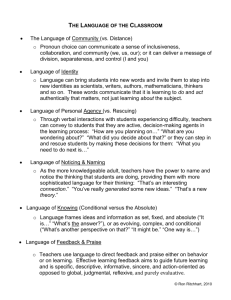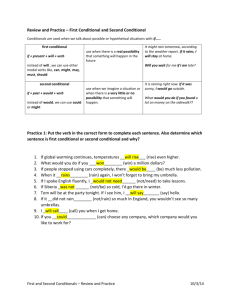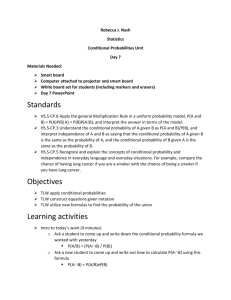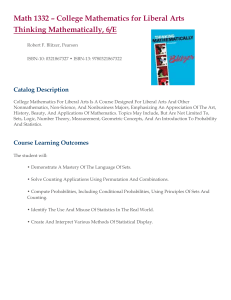S.CP.A.3 Lesson Conditional Probability
advertisement
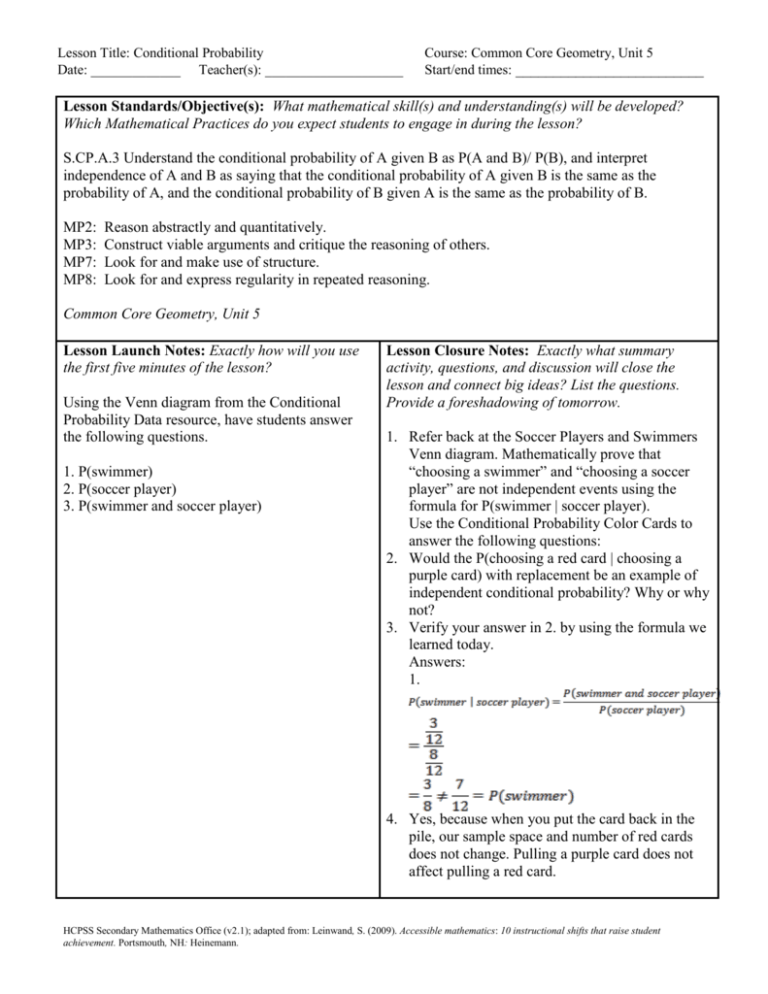
Lesson Title: Conditional Probability
Date: _____________ Teacher(s): ____________________
Course: Common Core Geometry, Unit 5
Start/end times: _________________________
Lesson Standards/Objective(s): What mathematical skill(s) and understanding(s) will be developed?
Which Mathematical Practices do you expect students to engage in during the lesson?
S.CP.A.3 Understand the conditional probability of A given B as P(A and B)/ P(B), and interpret
independence of A and B as saying that the conditional probability of A given B is the same as the
probability of A, and the conditional probability of B given A is the same as the probability of B.
MP2:
MP3:
MP7:
MP8:
Reason abstractly and quantitatively.
Construct viable arguments and critique the reasoning of others.
Look for and make use of structure.
Look for and express regularity in repeated reasoning.
Common Core Geometry, Unit 5
Lesson Launch Notes: Exactly how will you use
the first five minutes of the lesson?
Using the Venn diagram from the Conditional
Probability Data resource, have students answer
the following questions.
1. P(swimmer)
2. P(soccer player)
3. P(swimmer and soccer player)
Lesson Closure Notes: Exactly what summary
activity, questions, and discussion will close the
lesson and connect big ideas? List the questions.
Provide a foreshadowing of tomorrow.
1. Refer back at the Soccer Players and Swimmers
Venn diagram. Mathematically prove that
“choosing a swimmer” and “choosing a soccer
player” are not independent events using the
formula for P(swimmer | soccer player).
Use the Conditional Probability Color Cards to
answer the following questions:
2. Would the P(choosing a red card | choosing a
purple card) with replacement be an example of
independent conditional probability? Why or why
not?
3. Verify your answer in 2. by using the formula we
learned today.
Answers:
1.
4. Yes, because when you put the card back in the
pile, our sample space and number of red cards
does not change. Pulling a purple card does not
affect pulling a red card.
HCPSS Secondary Mathematics Office (v2.1); adapted from: Leinwand, S. (2009). Accessible mathematics: 10 instructional shifts that raise student
achievement. Portsmouth, NH: Heinemann.
Lesson Title: Conditional Probability
Date: _____________ Teacher(s): ____________________
Course: Common Core Geometry, Unit 5
Start/end times: _________________________
Lesson Tasks, Problems, and Activities (attach resource sheets): What specific activities,
investigations, problems, questions, or tasks will students be working on during the lesson? Be sure to
indicate strategic connections to appropriate mathematical practices.
1. Discuss the answers, as a class, to the lesson launch. P(swimmer) =
7
8 2
, and
, P(soccer player) =
12
12 3
3 1
. (Look for evidence of MP8.)
12 4
2. Use the Venn diagram from the lesson launch to answer the following questions developing an
the class how they developed
understanding of conditional probability. Have students tell
their
answers. Next to each question there are sample student answers. (Look for evidence of MP3.)
P(swimmer | soccer player) Look at only those soccer players who are swimmers, so the sample
space recedes to 8 from the total 12. Since 3 of the soccer players are also swimmers the probability
3
is equal to .
8
P(soccer | swimmer) Three of the swimmers play soccer and there are 7 swimmers so the
3
probability is .
7
Explain to the students that these are examples of conditional probability. (Look for evidence of MP7.)
P(AandB)
3. Show students that the mathematical algorithm for conditional probability is: P (A | B) =
.
P(B)
Ask students to use the formula to verify findings for P(soccer player | swimmer) =
.
P(swimmer and soccer player) =
4. Have students look at the two-way table “Students and Their Favorite Subjects”(located in Conditional
Probability Data). Have students use the conditional probability algorithm to find the following
probabilities. (Students can do this individually and share their answers within small groups or with the
class. Look for evidence of MP8.)
HCPSS Secondary Mathematics Office (v2.1); adapted from: Leinwand, S. (2009). Accessible mathematics: 10 instructional shifts that raise student
achievement. Portsmouth, NH: Heinemann.
Lesson Title: Conditional Probability
Date: _____________ Teacher(s): ____________________
Course: Common Core Geometry, Unit 5
Start/end times: _________________________
5. Divide the class into groups of three or four. Give each group a standard number cube and define event
A = {rolling a 6}, event B = {rolling a 3}. Ask students to find P(A | B).
, since A and B are independent situations, P(A and B) = P(A)*P(B).
Therefore,
Ask students what they recognize about the answer and the
question. P(A | B) = P(A) = P(B). Ask if students can postulate why this is true? (Answer: the two
events, A and B, are independent of each other since one roll of the die does not dictate the next.
Therefore, it would make sense that the probability of rolling a 6 would be equal to the probability
of rolling a 6 given a 3 has been rolled.) Note to students that it is not always true that all three
HCPSS Secondary Mathematics Office (v2.1); adapted from: Leinwand, S. (2009). Accessible mathematics: 10 instructional shifts that raise student
achievement. Portsmouth, NH: Heinemann.
Lesson Title: Conditional Probability
Date: _____________ Teacher(s): ____________________
Course: Common Core Geometry, Unit 5
Start/end times: _________________________
probabilities would be equal as shown in the next example. (Look for evidence of MP2.)
6. Give each group a set of the Conditional Probability Color Cards and define event A = {choosing a
blue card} and event B = {choosing a green card}. Have students use the algorithm to find P(choosing
a blue card | choosing a green card) after putting the green card back in the pile.
(Answer: P(A | B) = P(A and B) / P(B). Since A and B are independent events, P(A and B) =
P(A)*P(B). Then,
Students should be able to see right away P(B) will cancel out from the numerator and the
denominator so the overall answer is P(A) or 2/9. Thus, we see again that P(A | B) = P(A). These
last two examples demonstrate how A and B can be independent events if the conditional
probability of A given B is the same as the probability of A. Likewise, A and B are independent
events if the conditional probability of B given A is the same as the probability of B. Look for
evidence of MP 7.)
7. Have a discussion with the class to summarize the concepts learned in this lesson. Discuss real-world
conditional probabilities (the idea of narrowing down a sample space by having a ‘given’ event), how
conditional probabilities can be presented (Venn diagrams, two-way tables, situations with or without
replacement, situations where some event took place prior to another), and how some conditional
probabilities have independent events (when the first event does not affect the outcome(s) of the
second).
Evidence of Success: What exactly do I expect students to be able to do by the end of the lesson, and how
will I measure student success? That is, deliberate consideration of what performances will convince you
(and any outside observer) that your students have developed a deepened and conceptual understanding.
The Lesson Closure and the Homework will help to answer the questions:
Can students read a Venn diagram and find conditional probabilities based on the information provided?
Can students read a two-way table and find conditional probabilities based on the information provided?
Can students use a situation involving replacement in order to verify the independence of conditional
probabilities?
Notes and Nuances: Vocabulary, connections, anticipated misconceptions (and how they will be
addressed), etc.
Conditional Probability, P(A | B) = P(A given B), the probability of event A happening given event B has
occurred. The conditional probability can also be solved for the P(B | A) = P(B given A), the probability of
event B happening given event A has occurred.
Note conditional probability examples and questions should be limited to diagrams, tables and experiments
with replacement.
Resources: What materials or resources are
essential for students to successfully complete the
lesson tasks or activities?
Homework: Exactly what follow-up homework tasks,
problems, and/or exercises will be assigned upon the
completion of the lesson?
Conditional Probability Data
Six-sided number cubes
Conditional Probability Homework
HCPSS Secondary Mathematics Office (v2.1); adapted from: Leinwand, S. (2009). Accessible mathematics: 10 instructional shifts that raise student
achievement. Portsmouth, NH: Heinemann.
Lesson Title: Conditional Probability
Date: _____________ Teacher(s): ____________________
Course: Common Core Geometry, Unit 5
Start/end times: _________________________
Conditional Probability Color Cards
Conditional Probability Homework
Lesson Reflections: How do you know that you were effective? What questions, connected to the lesson
standards/objectives and evidence of success, will you use to reflect on the effectiveness of this lesson?
Were students successful with finding conditional probabilities given Venn diagrams and two-way tables?
Were students able to distinguish between independent conditional probabilities and dependent
probabilities?
Howard County Public Schools Office of Secondary Mathematics Curricular Projects has licensed this
product under a Creative Commons Attribution-NonCommercial-NoDerivs 3.0 Unported License.
HCPSS Secondary Mathematics Office (v2.1); adapted from: Leinwand, S. (2009). Accessible mathematics: 10 instructional shifts that raise student
achievement. Portsmouth, NH: Heinemann.




